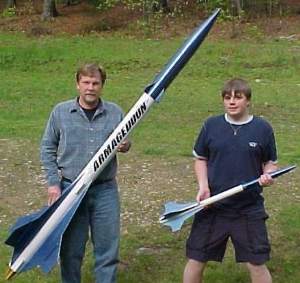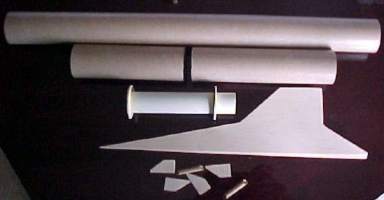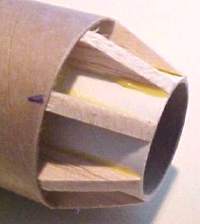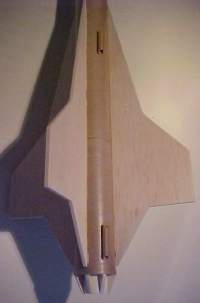Scratch Mini Armageddon Original Design / Scratch Built
Scratch - Mini Armageddon {Scratch}
Contributed by Drake "Doc" Damerau
| Manufacturer: | Scratch |
 Brief:
Brief:
I liked my
DG&A
Armageddon so much that I wanted to build a smaller version that I could
fly with my kids up at the school. I started with some Estes BT-60 body tubes
that I had leftover from another build. The original Armageddon has a 4"
body tube so that makes the BT-60 a 0.4 scale or 2.5 times smaller.
Bill of Materials:
- 2 BT-60 body tubes
- 2 BT 60 couplers
- 6" x 32" x 1/8" balsa fin stock
- One 5/16 x 1/8 balsa stick (Optional)
- 1 nosecone
- Centering rings
- Estes E-9, 24mm engine mount
- Two 3/16 launch lugs
- Parachute and shock cord
 Construction:
Construction:
Main Airframe
Cut one of the BT's to 5.25" and glue it to the full length BT-60 with a coupler. This tube coupled with a full 18" BT-60 will be your airframe. Cut a 6 5/8" section from the remaining BT-60. This will be the forward "payload" section.
Motor mount
 I used a 24mm engine mount
made for the Estes E-9 engines because it's a longer tube. I chose not to use
the engine hook and this enables to fly it on Estes D12's and Aerotech E motors
also. Tape must be used for a friction fit on the motor if the engine hook is
left out. Glue a centering ring to the end of the motor mount tube. Glue the
second centering ring to the MMT 7/8" from the other end and allow to dry.
Glue this assembly into the airframe so that the aft centering ring is
1/8" in the tube. Cut the balsa stick into eight 1" long pieces. If
you want, you can just make them from scrap leftover from making the fins. This
is how I did it. These pieces will make the finned tail cone. Glue the eight
pieces to the MMT so that they are evenly spaced and touch the centering ring.
This will make them 1/8" into the BT. I used 60 grit sand paper to taper
the eight tail cone fins from the BT to the MMT. It took all of ten minuets to
sand them to ! the taper. Finish them with 120 grit paper.
I used a 24mm engine mount
made for the Estes E-9 engines because it's a longer tube. I chose not to use
the engine hook and this enables to fly it on Estes D12's and Aerotech E motors
also. Tape must be used for a friction fit on the motor if the engine hook is
left out. Glue a centering ring to the end of the motor mount tube. Glue the
second centering ring to the MMT 7/8" from the other end and allow to dry.
Glue this assembly into the airframe so that the aft centering ring is
1/8" in the tube. Cut the balsa stick into eight 1" long pieces. If
you want, you can just make them from scrap leftover from making the fins. This
is how I did it. These pieces will make the finned tail cone. Glue the eight
pieces to the MMT so that they are evenly spaced and touch the centering ring.
This will make them 1/8" into the BT. I used 60 grit sand paper to taper
the eight tail cone fins from the BT to the MMT. It took all of ten minuets to
sand them to ! the taper. Finish them with 120 grit paper.
 Main fins
Main fins
Here is the hard part. You will need to do one of two things; download the RockSim file I made for the original Armageddon to get a fin template, or try to use the fin template jpeg. Just use the given dimensions and multiply them by 0.4 inches. You should end up with the root edge being about 12.5" long. I used Bud Nosen 6"x 32" x 1/8" A problem you will find here is that the grain of the balsa will be parallel to the BT. This makes for weak fins. Paint a coat of CY or epoxy to strengthen the fins. If you use CY, make sure you are in a well-ventilated room or better still, do it in the garage. Some people glue paper or cardstock to weak fins to strengthen them. This works well and cuts down on finishing time but it will make this rocket too heavy to fly on the Estes E motors. Make four fins and glue these so that the trailing edge of the root is 1/8" from the end of the tube. Make sure they are lined up with four of the tail cone fins.
Forward canard fins
These are much simpler to make. Using leftover stock from the fins cut out four fins to match the canards in the template jpeg. Glue them to the forward "payload section" so that they are flush with the end.
Nosecone / Parachute
I chose to use the Estes way of mounting the shock cord. The other end of the shock cord is just tied to the nosecone before it is friction fitted into the payload section. I used a 20" Aerotech parachute.
Finishing Touches
Cut the tips of the two 3/16" launch lugs at a 45-degree angle. Glue one
at the aft end of the rocket and one just behind the forward edge of the main
fins.
 Finishing:
Finishing:
I chose to paint the finned tail cone gold but (obviously) paint it as you
wish. Paint the fins, payload section and nosecone blue and the rest of the
body white.
Flight:
Flights I have flown this rocket at least two dozen times. Most flights have
been on a D12-5 but recently I've been using the new E-9 motors. Two successful
flights have been made on the Aerotech E30 and two on the E15. All flights,
like the original Armageddon, have been straight as an arrow and impressive.
Summary:
The only minor problem is that the 24mm MMT is larger in proportion to a BT-60
than the 38mm on my original Armageddon is to its 4" BT. The fins can be
hard to make if you don't have the originals to model them after.
 |
 |